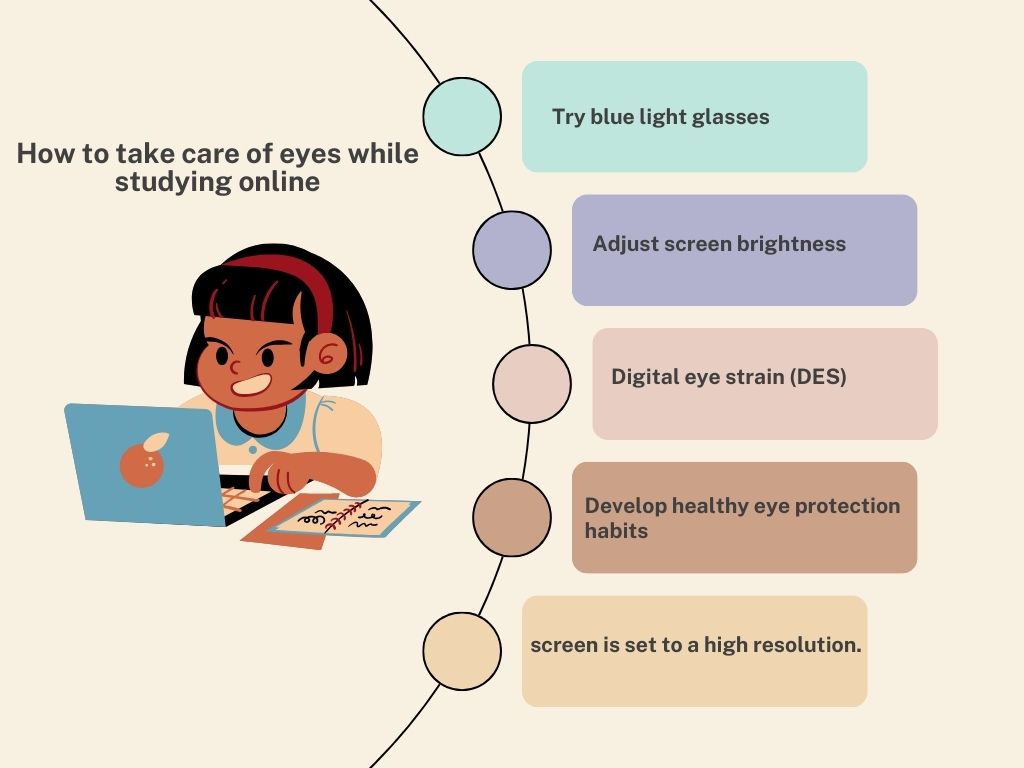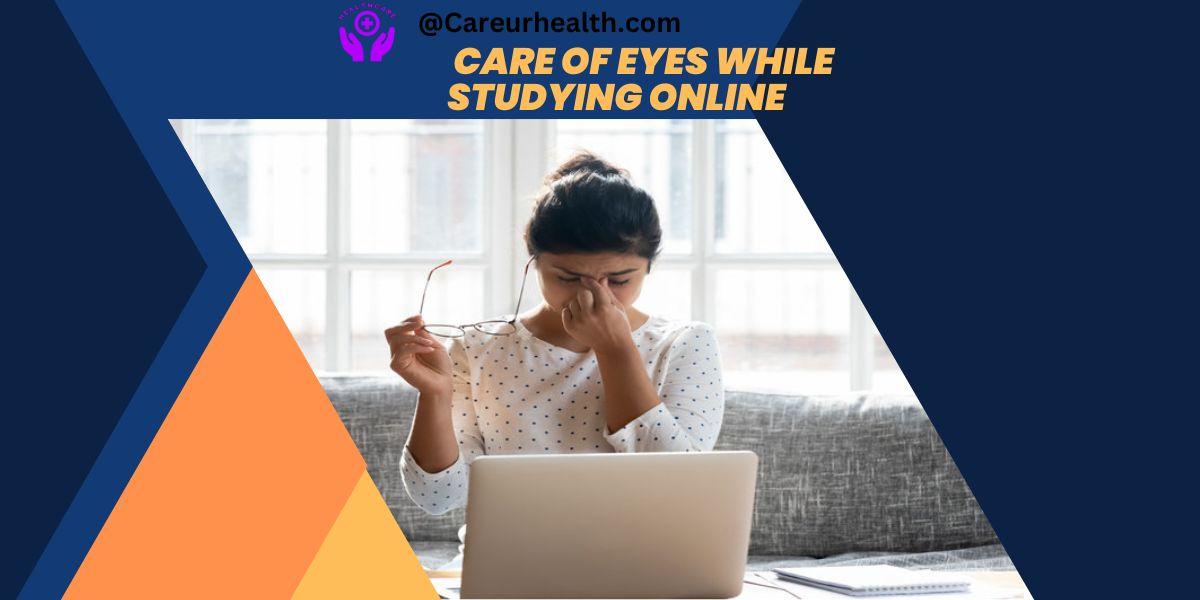From the rise of remote work to the fact that many children attend online courses all day long, the use of electronic devices continues to grow. With so much screen time per day, it’s time to take eye health seriously, especially for online students.
But if students need to use screens to participate in class, how can parents help their children avoid digital eye strain and take care of their eyes while studying online?
“Digital eye strain, also known as computer vision syndrome, can affect anyone who uses any type of electronic device, such as computers, smartphones, tablets, televisions, and gaming systems. In today’s digital environment, few hours of continuous use of an electronic device is all it takes to experience this”.

Real virtual students, like those at Connections Academy, don’t spend all day at a computer. There is time for reading, learning activities, breaks, and extracurricular activities. However, online schools have many ways to prevent eye strain when spending time in front of a screen.
Assess the student’s virtual learning environment and adjust as needed.
Reduce glare and avoid using the device outdoors by dimming the lighting in your room below that of your computer screen.
In digital school days, lower the brightness of the screen settings and increase the contrast. Check the distance between the screen and the student’s eyes. It should be between 20 and 30 inches from her face. Adjust the screen so that it is not tilted, and position it so that the top is just below eye level.
Make sure your computer screen is set to a high resolution.
- Adjust the colour settings on your device while your students do their homework or surf the web in the evening. For example, you can switch settings to Dark Mode to reduce blue light emission.
- Blue wavelength light emitted from digital screens stimulates the production of melatonin, which can affect your sleep if it’s too close to bedtime.
Develop healthy eye protection habits and take care of your eyes while studying online.
End the day with an eye-friendly lesson plan that includes off-screen activities like reading, sports, and hands-on learning to avoid the eye strain of online school. If your child is wondering, “How can I give my eyes a break?” teach them the 20-20-20 rule.
The American Optical Society recommends looking away from her screen for 20 seconds every 20 minutes and staring 6 feet away. If you find it hard to forget to take a break, apps like EyeCare and Workrave remind you with automatic notifications.
If the text is too small, enlarge it. On the Internet, you can do this by adjusting your web browser settings or using your browser shortcut keys.
Clean your computer screen at least once a week to keep it free of dust that can affect your vision.
Try blue light glasses
Although there is no evidence that blue light can cause permanent eye damage, reducing your child’s blue light exposure may help as a preventive measure.
If your child is exhibiting symptoms such as blurred vision or headaches after playing video games or working on the computer for long hours, consider using blue light glasses to reduce eye strain in your online school. It can be an option to
Schedule regular eye exams
Make eye exams part of your family’s regular health routine. Check with your child’s doctor about how often they should be tested and whether our recommendations work for your family.
Learn more tips for online school success from Connections Academy, which has over 20 years of experience.
- Due to the spread of the novel coronavirus disease (COVID-19), most schools, colleges, and coaching organizations have adopted an online teaching model.
- We now offer daily lectures using online courses. During this lockdown period, online courses are a real support for students to continue learning without interruption.
- Both teachers and students have started to adopt this new learning model and are learning every day as they would in an offline class. Considering the overall situation of online education in the country, it can be said that there are many pros and cons to online learning.
- Eye strain is one of the disadvantages of online courses and cannot be completely avoided. So here are some tips to reduce eye strain from online courses/learning and take care of your eyes while studying online. For more tips on reducing eye strain, read the full article.
Use Laptops/Tablets
The first thing students should keep in mind is that they should avoid using mobile phones for online teaching and learning. Students are encouraged to use large screens, such as laptops, computers, and tablets, to reduce eye strain.
Adjust screen brightness –
Students should adjust the brightness of their laptop or tablet screen to reduce eye strain. Encourage students to lower the screen brightness and increase the contrast for better viewing. These adjustments can be made through your device settings.
Adjust room lighting. In addition to adjusting screen brightness, students should also ensure that room lighting is suitable for online learning.
The lighting in the room should be darker than the computer screen to reduce eye strain. The lighting in the room is perfectly coordinated, reducing glare and making it easier for students to see the screen.
“Don’t keep staring at the screen. Remind students not to stare at the screen too long. The student cannot take a break during the lecture, but she only needs to look elsewhere for 10–20 seconds to reduce eye strain. Rest your eyes between lectures”.
Get plenty of rest –
In addition to following the tips above to reduce eye strain from online courses and take care of eyes while studying online, students should get plenty of rest for the day after class. Doing so will ease her eyes and give them much-needed rest.
Avoid Playing Video Games.
Online classes already have students using electronic devices for at least 4-5 hours per day, so students should not play video games or watch videos for long periods on their mobile devices. It is recommended that you do not look at it.
Students can engage in other leisure activities that do not require electronic devices, such as indoor games or listening to music. Students should set usage limits when they cannot refrain from using mobile phones or other devices for leisure activities.
Besides these tips, students should try to sit in an ergonomic posture that reduces eye strain and takes care of their eyes while studying online.
Ergonomic posture means students sit with their feet flat on the floor, shoulders relaxed, hips supported, and arms at right angles so that their forearms are in line with the keyboard. To do. Students should also clean their computer screens regularly.
Digital eye strain (DES)
Digital eye strain (DES) is more prevalent than ever these days, as virtually everyone uses screens in their daily lives.
Not everyone sits in front of a computer screen every day, but most people use smartphones. Experts estimate that about 50% of his computer users have experienced DES.
So, do screens make your eyesight worse? Fortunately, eye strain is not a long-term problem. There is no evidence that excessive exercise causes long-term vision loss, but it causes extreme discomfort and makes everyday tasks more difficult.
Looking at a high-definition screen can subconsciously reduce blinking, subside other pain responses, and make your body feel like nothing is wrong. This is especially common when using computers and is called “computer vision syndrome.”.
Over the long term, this can negatively impact the overall health of your eyes. If you work at a computer all day long, you may experience these symptoms after using the screen for a long time.
Read Also:-
- Benefits of Kapalbhati and Anulom Vilom: Ancient Breathing Techniques for Modern Well-Being
- Apply These 5 Secret Techniques To Improve Get Rid Of Dark Spots On The Face Naturally
- Unlock the Power of Sleep:10 Useful Tips to Sleep Better
The Yoga Institute










